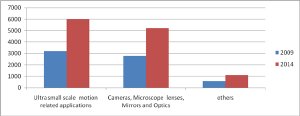Jul 13 2010
A confluence of new piezo-based technology has breathed new capability into the nano- and micro-positioning world. Piezo actuation is increasingly suitable for applications formerly addressable only by magnetic motors, and the technology offers significant benefits in terms of size, speed, fieldlessness, reliability, vacuum compatibility, resolution and dynamics.
 Global share for piezoelectric actuators and motors by application, 2009 and 2014 ($ Millions)
Global share for piezoelectric actuators and motors by application, 2009 and 2014 ($ Millions)
These benefits, in turn, enable significant advances in existing and new applications. Piezomotors and actuators typically eliminate any need for gear reduction because they drive loads directly. Piezoelectric actuators have been commercialized in various areas such as information technology, robotics, biomedical engineering, automotive, ecological and energy engineering.
According to a recently published report from iRAP, Inc., Piezoelectric Actuators and Motors – Types, Applications, New Developments, Industry Structure and Global Markets, the global market for piezoelectric-operated actuators and motors was estimated to be $6.6 billion in 2009 and is estimated to reach $12.3 billion by 2014, showing an average annual growth rate (AAGR) of 13.2% per year.
The market for piezoelectric-operated actuators and motors in ultra-small scale precision motion related applications will be the largest segment, estimated to have reached $3,200 million (48.6% share) in 2009 and projected to reach $6,000 million in 2014, for an AAGR of 13.4%. The other major segment includes phone cameras, digital cameras, microscope lenses, mirrors and optics, estimated at $2,800 million (42.5% share) in 2009 and $5,200 million in 2014, for an AAGR of 13.1%.
The remaining 8.9% ($587 million) is a third market segment consisting of auto fuel injectors, micro-pumps, micro-blowers, printer cartridges, surgical instruments, mini-robots, etc.). In 2014, this market segment will have a share of 8.7% ($1,090 million).
The manufacturers of optics, photonics and nanometrology equipment have been the major consumers of piezoelectric-operated motors and actuators.
Life sciences and medical technology also constitute a high-growth segment of the piezoelectric-operated actuators and motors market. This area is expected to grow at 18.7% annually and could record an even higher growth rate if there is wider acceptance by end users. It is still going through a gestation period.
Over the projected period of five years, market share of piezoelectric-operated actuators and motors will increase, taking share from electromagnetic motors.
In terms of types, bulk PZT material-based piezo actuators and motors have the highest market share at 98%, with a market of US$6.455 billion in 2009; this segment will grow at an AAGR 12.4% to reach US$11.6 billion in 2014. Thick-film PZT used in piezo actuators and motors reached a market of US$65.83 million in 2009, approximately 1% of the total, and will show an AAGR of 30.1% to reach US$245.8 billion in 2014. Fiber composites used in actuators and motors had a market of US$39.52 million in 2009, and by 2014, with an AAGR of 50.7 %, the segment will reach US$307.2 million in sales. Lead-free ceramics used in actuators and motors had a market of US$26.345 million in 2009 and is expected to reach US$123 million by 2014, for an AAGR of 36%.
In terms of regional market share, North America leads, with 40.5% in 2009, followed by Europe with 34%, Japan with 20%, and the balance 5.5% for China and the rest of the world.